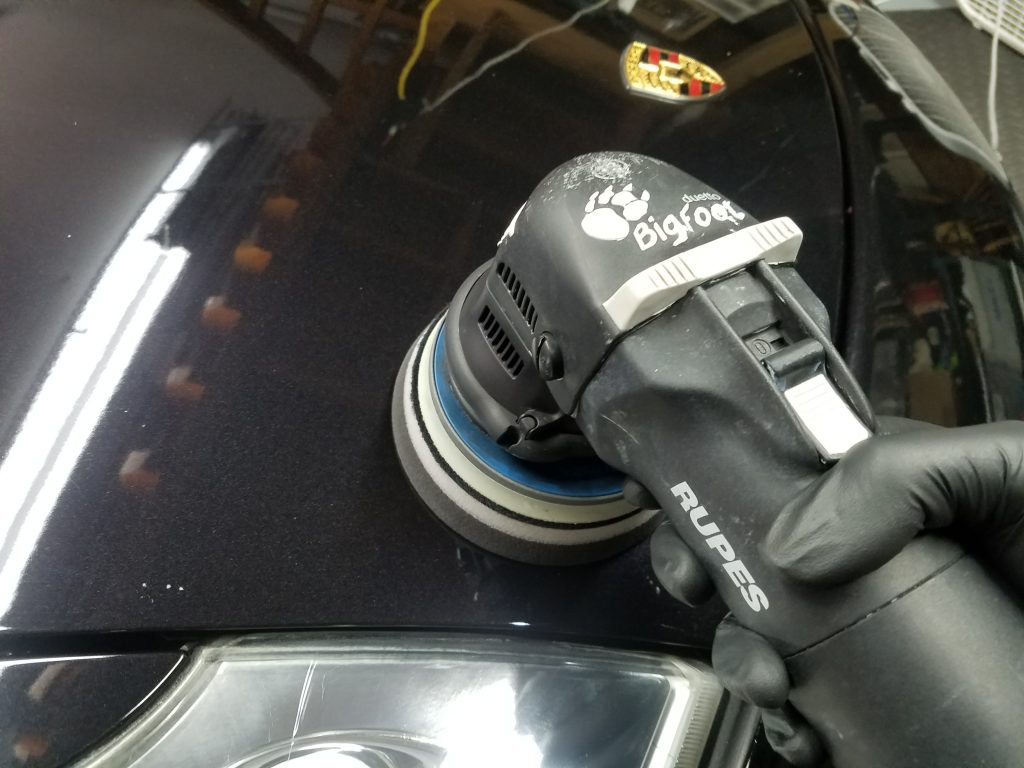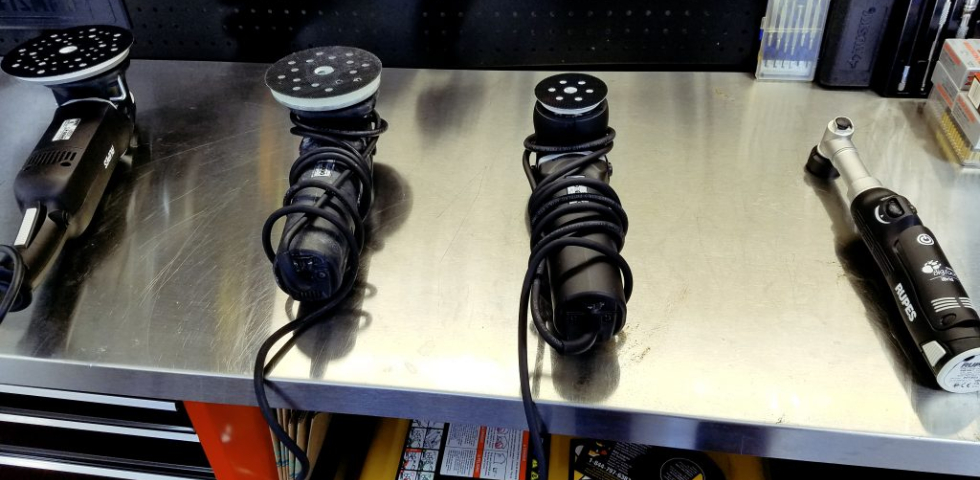
The (polishing) tool is an instrument in the art and science of detailing. It is as effective as the technician’s understanding of its attributes and consequentially skill in application. Whether a $100 or a $600 polisher(s), a long throw polisher, a force rotation, or a rotary, it is not the tool that makes you a REAL detailer. It is the passion in maximizing your choice of resources for results that makes you a professional.
My experiences with the Rupes polishers include the following:
- Rupes BigFoot Random Orbital Polisher LHR 12E Duetto (center left)
- Rupes BigFoot Random Orbital Polisher LHR 75E Mini (center right)
- Rupes BigFoot Random Orbital Polisher Mark II 21MM (far left)
- Rupes BigFoot iBrid Nano – Long Neck (far right)
It is not uncommon for me to use all of these polishers for a single car detail. For those that are interested in getting better results, I hope you understand that a different kind of fine polish, compound, pad type, pad choice, polisher throw (DA, Rotary, Force), and more importantly combinations of these, can alter your results. Many people do not realize the pad type can not only lead to unique results based on choice of polishers, but many are not very compatible with certain types of polishers. Mastering your own system has value. F0r all of those who inquire about why you are not getting the consistent results you want, it would help those trying to help you to detail your process, as well as mention your polish, polisher, and pad choice. When people ask you to be more specific please do better than saying, “yellow pad.”
The pads (show directly below) are incompatible with the Rupes polishers shown above. They could not handle the power of the polishing ‘throw’. I would not recommend these pads for other long throw, force rotation, or rotary polishers. Think about putting an engine from a typical car into a high performing one. Nevertheless these pads served me well with my first polisher, the Porter Cable.
I used these pads (seen above) mostly Lake Country CCS, with my first polisher, the Porter Cable 7424XP.
The Porter Cable is considered an entry level Dual Action polisher. I have had good results and early on took steps back learning a different tool and pad combination, with the Rupes Duetto. But the user experience once I improved my technique with the Duetto and reduction in wear on my body was appreciated.
The Rupes Yellow Polishing Pad is my most commonly used and likely one of if not most often used in the detailing industry (shown below). This is the case for multiple reasons. It doubles as a refinement step polishing pad, i.e. the jeweling polishing step in a two stage correction. This second step of polishing (refinement), post aggressive compounding, is usually necessary for professional results. It provides good results with a variety of polishes for a single step of polishing. It also pairs well with all of the Rupes polishers shown.
The other Rupes pads historically have not been as popular in the industry. But with recent evolution to their pad design that might change?
Other pads I have used for 1 Stage polishing or Refining
- Lake Country HDO Black Finishing Pad
- Rupes Yellow Polishing Foam Pad
- Lake Country HDO Blue Cutting Pad
The Rupes Yellow Polishing Foam Pad is the pad I will most often turn to, by far. But I have used these other pads for 1 stage correction (single step polishing). Although I have used the Lake Country HDO Blue Cutting Pad more for a light 2 stage correction, sometimes I will use it for a single step on very hard clear coats. Some Mercedes models and some Corvette models come to mind.
Compounding Step, Rupes Dual Action Preferred Pads:
I found the Lake Country Microfiber (or microfiber cutting pads in general) to be the most aggressive of the three pads options mentioned here when using a dual action, particularly long throw polisher. It pairs well specifically with DA polishers, standard (Porter Cable) or long throw. If I was looking to be more aggressive with the rotary or force rotation polisher, I would choose the Wool Pad options, although I found the Rupes Wool pads to be universally effective. I often use the UroFiber, show in the picture above, when I want a moderately aggressive cut with my (DA) Dual Action polisher.
A Breakdown Of The Polishers
The mention of the Rupes Ibrid has elicited strong mixed reactions even amongst those that regularly use Rupes polishers. This polisher has been a great benefit and worthwhile investment in my business. The minor complaint I have is the battery life, while the major complaint amongst the auto detailing community is the lack of correcting power. In terms of its battery power, it has not significantly inconvenienced me and I have purchased an additional battery for all around insurance. I do believe there is some validity to the complaint about its lack of correcting power. I would even argue based on feedback within the industry (and personally) that if you do not need a one inch option, a good case can be made for the Flex Pxe 80 miniature polisher. In defense considering it is a polisher with a one inch option, it realistically should be used in a relatively smaller working area. People often polish to big of an area at a time, leading to unmet expectations. Often not achieving good correction is a result of the person treating a miniature polisher like a larger one. There is no such thing as a quick buff, paint correction takes time. Although I do believe the Flex is likely stronger, the smaller the polishing pad throw (diameter of its orbit) the more you need to shrink your working area.
Which leads to an important point! I enjoy and will likely continue to prefer my current setup of polishers. But to really unlock the benefits of a Rupes DA or likely any long throw polisher, you are going to have to invest in multiple polishers. One of the disadvantages of the Rupes long throw DA polishers is pad stalling which leads to incomplete paint correction. This is also in addition to the many convex and concave car panels that inhibit a pad from doing its job due to it not being flat on a car panel. Although the curvature issue along with intricate areas, more common lately with the design of modern luxury cars, is also an issue with any style polisher. The more recent Mark II and Mark III models (consequentially more premium priced) have noticeably improved the performance of the Rupes polishers with respect to pad stalling.
The Rupes Mini has always been my favorite polisher.
The Mini (12mm throw) is the most utilized and user friendly between the 15inch and 21inch polishers. Even working with the Mark I (legacy) and investing in the superior Mark II, the Mini (12inch) is my favorite polisher. There is a problem.
Without a doubt pad stalling and consequentially the needd to invest in multiple polishers in order to really optimize the tools, has turned many detailers away from Rupes long throw dual action polishers. When working less frequently on completely long and flat surfaces the number of polishers, and even more importantly your skill (which fatigue may affect) in keeping the pad rotating, plays a significant role in achieving great results and overall great user experience. The force rotation deals with landscape changes (various car shapes) somewhat better. But every polisher has its inherit strengths and weaknesses.
Rupes long throw polishers are known for jeweling paint very well and being more forgiving as a last polishing step, which is the most underrated part of the paint correction process. Refinement advantage goes to the long throw DA almost to a fault with some pads compromising the finish if they are too soft. This is another reason why the Rupes Yellow pads are so popular. But you could counter with force rotation polishers potentially being inherently more aggressive at correcting paint. The force rotation polishers like the Flex 3401 feel a little bit like riding a bronco or bull. I do not think it is so bad as long you are open to differences, but there is a love versus hate experience with that style of polisher as well.
If I was considering a force rotation, the Flex 3401 (seen below) is a good starting point with the addition of the Pxe 80 very popular in the future.
Rupes Brand – hidden value of quality. Specialty training, customer service (though repairs may take a while). I have had an excellent customer service experience with Rupes.
- Rotary – depending on the skill level, many have reported superior results. But ultimately skill of the technician is what’s most important and all tools can damage simply based upon the fact that clear coat is being removed.
- Force Rotation – refinement disadvantage, but can be helped with very soft pads.
- Long Throw – refinement advantage, but potentially also a disadvantage with pads that are very soft.
Link to a more in depth description of each polisher sold here.
